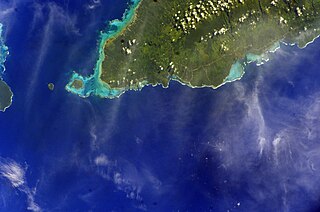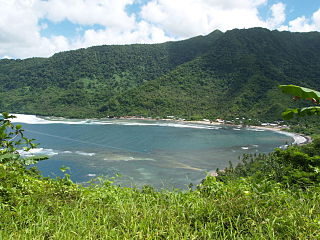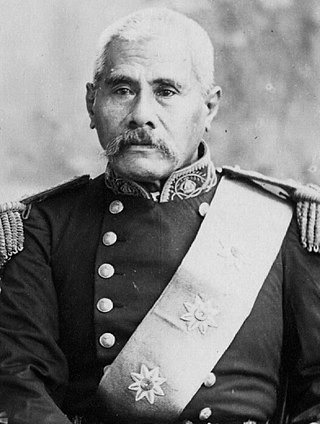
Politics of Samoa takes place in a framework of a parliamentary representative democratic state whereby the Prime Minister of Samoa is the head of government. Existing alongside the country's Western-styled political system is the fa'amatai chiefly system of socio-political governance and organisation, central to understanding Samoa's political system.
Queen Salamasina was a powerful and high-ranking woman in Samoan social history. She held the four papā (district) titles which gave her the paramount status of Tafa‘ifā on the western islands of Samoa. Contrary to popular belief she was not the first Tafa'ifā, as these titles were willed to her by their previous possessor, Nafanua. She is the titular ancestor of two of the four paramount titles of Samoa, Tupua Tamasese of Falefa and Salani and the Amaile Mataafa line.

Samoa is made up of eleven itūmālō. These are the traditional eleven districts that were established well before European arrival. Each district has its own constitutional foundation (faavae) based on the traditional order of title precedence found in each district's faalupega.

Aʻana is a district of Samoa. It is on the western third of Upolu island, with a small exclave surrounded by Aiga-i-le-Tai. It has an area of 193 km2 and a population of 23,265. The main centre is Leulumoega.

Ātua is an ancient political district of Samoa, consisting of most of the eastern section of Upolu and the island Tutuila. Within Samoa's traditional polity, Ātua is ruled by the Tui Ātua together with the group of six senior orators of Lufilufi and 13 senior matai from throughout Ātua, comprising the Fale Ātua. The fono (meeting) of Atua's rulers takes place in Lufilufi on the great malae of Lalogafu'afu'a.

Vaʻa-o-Fonoti is a district on the north east coast of Upolu Island in Samoa, with a population of 1,621, making it the least populated district in the country and the Second smallest one by area after Aiga-i-le-Tai.

Nafanua was a historical ali'i (chief/queen) and toa (warrior) of Samoa from the Sā Tonumaipe'ā clan, who took four pāpā (district) titles, the leading ali'i titles of Samoa. After her death she became a goddess in Polynesian religion.

Susuga Malietoa Laupepa was the ruler (Malietoa) of Samoa in the late 19th century. He was first crowned in 1875.

Tupua (known as Tupua Tamasese) is a state dynasty and one of the four paramount chiefly titles of Samoa, known as the Tama-a-Aiga or 'Sons of the Great Families'). It is the titular head of one of Samoa's two great royal families - Sā Tupua, the lineage of Queen Salamasina. The 'Tupua' refers to Salamasina's descendant, King Tupua Fuiavailili, who was the first to unite both of Salamasina's descent lines in his personage and ascended to the Kingship of Samoa in c.1550, upon the death of his adoptive father, King Muagututi'a. Tupua Fuiavailili was adopted by his aunt, Fenunu'ivao (daughter of Leutele and wife of King Muagututi'a) and named as the King's successor. Tupua's rise also led to the first usage of the term "Tama-a-'aiga" by the orator polity of Leulumoega and Lufilufi, in reference to his many genealogical connections to the great families of Ātua. The 'Tamasese' part refers to his descendant Tupua Tamasese Titimaea, whose prowess in battle and generosity won favour with many of his followers and whose actions restored the Salamasina line's prestige. All subsequent Tupua title holders have thus carried the two names together since then.

Aunuʻu is a small volcanic island off the southeastern shore of Tutuila in Saʻole County, American Samoa. It has a land area of 374.83 acres, and a 2010 census population of 436 persons. Politically, it is a part of the Eastern District, one of the two primary political divisions of American Samoa.
The Tuʻipelehake is the second highest ranking chiefly title in Tonga. In the absence of the ancient Tuʻi Faleua title, the Tuʻipelehake title is second in rank after the King's title, Tuʻi Kanokupolu. There have been several holders of the title mainly from the ruling royal family, from princes to prime ministers. It is Tongan custom to refer to the holder by his customary title, only adding his given name if confusion may arise. For example, Tuʻi Pelehake (ʻUluvalu).
Tuʻi-tā-tui(translation: The king who strikes the knee) was the 11th king of the Tuʻi Tonga, a dynasty in Tonga, who lived during the 12th century AD.
Le Susuga Malietoa Talavou Tonumaipeʻa was installed as "King" of Samoa to the western world on August 28, 1879, until his death on November 9, 1880. Since Malietoa Talavou's half brother's death, Malietoa Moli in 1860, ongoing wars due to power and authority struggle between Talavou and Laupepa over the next Malietoa title holder and the gaining of support by the districts of Samoa. Family rivalry existed as did a 30-year age difference drew a wedge between Malietoa Laupepa and Malietoa Talavou. They were known to be longtime rivals over the Malietoa title.

Falefā is located on the north eastern coast of Upolu island in Samoa. It was the ancient capital during the ‘Malo’ (‘government’) of Tupu Tafa'ifa (King) Fonoti. After having defeated his siblings Va'afusuaga and Samalaulu for control of Samoa, King Fonoti chose to rule from his new seat in Falefa, an honour remembered in its faalupega to this day.

Fa'amatai is the indigenous political ('chiefly') system of Samoa, central to the organization of Samoan society. It is the traditional indigenous form of governance in both Samoas, comprising American Samoa and the Independent State of Samoa. The term comprises the prefix fa'a and the word matai.

Sina and the Eel is a myth of origins in Samoan mythology, which explains the origins of the first coconut tree.
Samamea is a village on the north east coast of Upolu island in Samoa. It is the main village or 'capital' of the political district Va'a-o-Fonoti. The village's population is 45.
Ama is a title originating c. 1400 AD, and bestowed upon the paramount chief and commander in war of the district of Safata, situated south of the island of Upolu, within the country of Samoa. It is a hereditary title. The title originated from Lotofaga, a village within the Safata district. Lotofaga is a village that sits in the middle of the Safata Bay. The village has been described as the following: 'Here the surf is sometimes so wild that one cannot sleep because of the roar; therefore it is called Galutatu'. It is also known as Le-Faga-o-Alii, translated in Samoan as 'The Bay of Chiefs'. This is in reference to the Ama that resides there. Lotofaga is traditionally known to be a village of refuge for those in need as well as a place to observe and learn of Samoan chief customs and etiquette.

Coronations in Oceania are, or were, held in the following countries:

AfiogaTuimalealiʻifano Vaʻaletoʻa Eti Sualauvi II is a Samoan politician who is the current O le Ao o le Malo of Samoa, in office since 2017.















